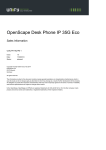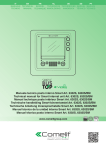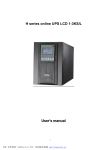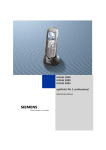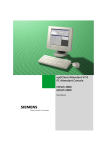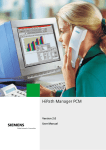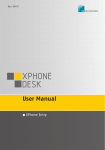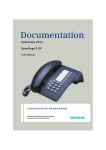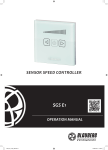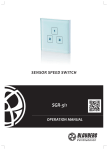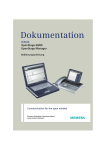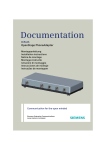Download to the User Guide - Cumulus Communications Group
Transcript
Operation
OpenStage Manager
OpenStage 60/80
www.siemens.com/enterprise
General notes
General notes
This document describes how to install, configure, and operate PC management software
OpenStage Manager.
All OpenStage Manager functions are described. If some functions are not available to you,
this may be due to one of the following:
• Your phone does not support that function. For more information on applying individual
OpenStage Manager functions on your phone, refer to this manual and the documentation supplied with your phone.
• The version of OpenStage Manager software installed on your PC is out of date.For information on how to install the latest version, consult your system administrator.
The information provided in this document contains merely general descriptions or
characteristics of performance which in case of actual use do not always apply as described or which may change as the result of further development of the products.
An obligation to provide the respective characteristics shall only exist if expressly agreed
in the terms of the contract.
All trademarks are the property of Siemens Enterprise Communications GmbH & Co. KG
or their respective owners.
User manuals
The latest version of this manual and all those named in the List of references (Æ page 51)
are available for Internet download as PDF documents at
www.siemens.com/enterprise/ > Downloads > User Manuals.
You will need Adobe Reader to read or print these documents.
You can download Adobe Reader from the Internet at http://www.adobe.com/.
Please read the user manuals carefully before operation.
Up-to-date information on software described
The .zip file also contains the file readme.txt. This text document contains important additional information that only came to light after the publication of the manual. Please read
the additional information contained in the readme.txt file carefully. Refer also to the online product information at http://www.siemens.com/hipath/ > Downloads.
2
Contents
Contents
General notes . . . . . . . . . . . . . . . . . . . . . . . . . . . . . . . . . 2
User manuals . . . . . . . . . . . . . . . . . . . . . . . . . . . . . . . . . . . . . . . . . . . 2
Up-to-date information on software described . . . . . . . . . . . . . . . . . 2
Information on the documentation. . . . . . . . . . . . . . . 5
Notes . . . . . . . . . . . . . . . . . . . . . . . . . . . . . . . . . . . . . . . . . . . . . . . . .
Procedural instructions . . . . . . . . . . . . . . . . . . . . . . . . . . . . . . . . . . .
Lists . . . . . . . . . . . . . . . . . . . . . . . . . . . . . . . . . . . . . . . . . . . . . . . . . .
Cross references . . . . . . . . . . . . . . . . . . . . . . . . . . . . . . . . . . . . . . . .
Areas of application for the software . . . . . . . . . . . . . . . . . . . . . . . . . . .
5
5
5
5
6
Installation . . . . . . . . . . . . . . . . . . . . . . . . . . . . . . . . . . . 7
System requirements . . . . . . . . . . . . . . . . . . . . . . . . . . . . . . . . . . . . . . . 7
Before installation . . . . . . . . . . . . . . . . . . . . . . . . . . . . . . . . . . . . . . . 8
OpenStage Manager installation procedure . . . . . . . . . . . . . . . . . . . . . . 8
OpenStage Manager - installation . . . . . . . . . . . . . . . . . . . . . . . . . . . . . . 9
Starting setup . . . . . . . . . . . . . . . . . . . . . . . . . . . . . . . . . . . . . . . . . . 9
Setup wizard . . . . . . . . . . . . . . . . . . . . . . . . . . . . . . . . . . . . . . . . . . . 9
Logging your phone on . . . . . . . . . . . . . . . . . . . . . . . . . . . . . . . . . . 15
Connection information on the Windows system tray . . . . . . . . . . 16
User interface. . . . . . . . . . . . . . . . . . . . . . . . . . . . . . . . 17
Phone Book Maintenance . . . . . . . . . . . . . . . . . . . . . . . . . . . . . . . . . . .
Phonebook Editor . . . . . . . . . . . . . . . . . . . . . . . . . . . . . . . . . . . . . .
Automatic synchronization. . . . . . . . . . . . . . . . . . . . . . . . . . . . . . . .
Manual synchronization . . . . . . . . . . . . . . . . . . . . . . . . . . . . . . . . . .
Synchronization parameters. . . . . . . . . . . . . . . . . . . . . . . . . . . . . . .
Importing a CSV file . . . . . . . . . . . . . . . . . . . . . . . . . . . . . . . . . . . . .
Images . . . . . . . . . . . . . . . . . . . . . . . . . . . . . . . . . . . . . . . . . . . . . . .
Groups . . . . . . . . . . . . . . . . . . . . . . . . . . . . . . . . . . . . . . . . . . . . . . .
Key Configuration . . . . . . . . . . . . . . . . . . . . . . . . . . . . . . . . . . . . . . . . .
Screensaver. . . . . . . . . . . . . . . . . . . . . . . . . . . . . . . . . . . . . . . . . . . . . .
Transferring images to the phone . . . . . . . . . . . . . . . . . . . . . . . . . .
Deleting a screensaver image . . . . . . . . . . . . . . . . . . . . . . . . . . . . .
Changing the screensaver name . . . . . . . . . . . . . . . . . . . . . . . . . .
Saving a screensaver image on the PC . . . . . . . . . . . . . . . . . . . . . .
Changing the screensaver overview . . . . . . . . . . . . . . . . . . . . . . . .
18
19
24
28
32
35
36
39
41
44
45
45
45
46
46
3
Contents
Ringtones . . . . . . . . . . . . . . . . . . . . . . . . . . . . . . . . . . . . . . . . . . . . . . .
Transferring audio files to the phone . . . . . . . . . . . . . . . . . . . . . . .
Performing an audio test for available audio files . . . . . . . . . . . . . .
Deleting audio files . . . . . . . . . . . . . . . . . . . . . . . . . . . . . . . . . . . . .
Changing audio file names. . . . . . . . . . . . . . . . . . . . . . . . . . . . . . . .
Saving an audio file in the PC . . . . . . . . . . . . . . . . . . . . . . . . . . . . .
Changing the audio file overview . . . . . . . . . . . . . . . . . . . . . . . . . .
List of references . . . . . . . . . . . . . . . . . . . . . . . . . . . . . . . . . . . . . . . . .
SIP variants . . . . . . . . . . . . . . . . . . . . . . . . . . . . . . . . . . . . . . . . . . .
HFA variants . . . . . . . . . . . . . . . . . . . . . . . . . . . . . . . . . . . . . . . . . .
Accessories . . . . . . . . . . . . . . . . . . . . . . . . . . . . . . . . . . . . . . . . . . .
47
48
48
49
49
49
50
51
51
51
51
Index. . . . . . . . . . . . . . . . . . . . . . . . . . . . . . . . . . . . . . . .52
4
Information on the documentation
Information on the documentation
Notes
This symbol indicates additional notes and comments on the current topic.
Procedural instructions
1. Numbered bullet points describe actions that need to be taken in the
order specified.
Lists
•
Lists are marked with this symbol.
Cross references
Cross references are marked with "Information on the documentation" or
Æ page 5 and refer you to a section in this manual that provides further information on the topic.
If you open this document in PDF format, you can click these symbols to
jump directly to the references on the relevant page.
5
Information on the documentation
Areas of application for the software
OpenStage Manager is suitable for the following models:
• OpenStage 60/80 (SIP/HFA)
• OpenStage 60G/80G (SIP/HFA)
Phone Book Maintenance
The main function of OpenStage Manager is to act as an interface between your telephone and your PC for more transparent and simpler PCbased phonebook maintenance.
Assignment of images to contacts
You can add a personal image for each contact. If the person associated
with this contact calls you, his or her the image appears along with relevant
contact data on your phone’s display.
Individual call signaling for groups
Every contact can be assigned to a group and a separate ringtone can be
configured for every group.
Example:
All contacts in the company’s Frankfurt branch are assigned to the "Frankfurt" group. This group is assigned a ringtone that plays the melody "Für
Elise". You immediately know which group is calling simply on the basis of
the call signal.
Groups are frequently also configured for categories such as "SME customers", "key accounts", "private" or else for individuals, such as "Daughter"
or "Boss".
Synchronizing contacts
Contact data can be synchronized between Microsoft Outlook and OpenStage 60/80. This makes it easy to transfer new entries in Microsoft Outlook to the OpenStage phone.
You can also import contact data in the form of csv files from the Siemens
optiPoint or Optiset E memory phone ranges.
Key programming (SIP phones only)
The programmable keys on the right of the phone’s display are easy to program with OpenStage Manager.
Screensaver
A screensaver is easy to configure for the phone display. It plays a slideshow of attractive landscapes or personal images.
6
Installation
Installation
System requirements
To operate OpenStage Manager without restriction, you must ensure the
following requirements are fulfilled.
Hardware
• Processor with at least 1 GHz
• RAM: at least 512 MB
• 75 MB free storage on the hard drive
• CD-ROM or DVD drive (if the software is provided on CD/DVD)
• Screen resolution: at least 1024 x 768 pixels
Software
• Operating system:
Windows 2000 (Service Pack 4)
Windows XP (Service Pack 2)
Outlook 2003 (Service Pack 2)
User authorization
For Windows 2000 and XP operating systems, you must log on with administrator rights before installation. If necessary, contact your service
personnel.
7
Installation
Before installation
1. Use the latest version of OpenStage Manager. For more information,
consult your service personnel.
2. Decompress the .zip file with a suitable program
(such as WinZip - available free of charge at http://www.winzip.com/).
3. Ensure you have the information below to hand.
– IP address of the phone
– DNS domain (DNS name, if available)
– User password of the phone (must be configured)
For more information about the IP address and domain, contact your
service personnel or refer to the Network information overview in
the user part of your OpenStage phone’s service menu.
The phone does not ship with a user password. If you have not yet
configured a password, do so now as otherwise you cannot log the
phone on via the OpenStage Manager service program.
For OpenStage documentation, see Æ page 51.
OpenStage Manager installation procedure
1. Install Microsoft .NET 2.01, see Æ page 9.
2. Install the OpenStage Manager software, see Æ page 10.
3. Log the phone on using the OpenStage Manager (Connection Service),
see Æ page 15.
[1]. Microsoft .NET 2.0 is a product from Microsoft Corp. and not included in the default Windows installation. The shareware package can be downloaded free of charge on the Internet, can be loaded using the Windows Update function and is also included in the Phone
Manager’s installation package. Security updates are provided after installation by the automatic Windows Update function.
8
Installation
OpenStage Manager - installation
Starting setup
You will find the OpenStage Manager software in the English folder after
you have decompressed the .zip file.
1. Double-click OpenStage Manager Setup.exe.
2. Follow the setup wizard instructions.
Decompress the .zip file in the preset structure only. Modifying this
structure (for instance, saving the files in the "Setup" subfolder with
the "OpenSetup Manager Setup.exe" file at the same level) can obstruct the installation routine.
Setup wizard
Installation involves a number of steps which all require the selection of options.
Click Back to return to the previous selection.
Click Cancel to exit the installation routine.
1. If the Microsoft .NET 2.01 application is not yet installed on your PC,
the setup wizard will install it automatically. If Microsoft .NET 2.01 is
already installed, OpenStage Manager installation begins directly with
OpenStage Manager setup (see Æ page 10).
Accept the terms of the Microsoft .NET 2.01 license agreement by
clicking Accept.
[1]. Microsoft .NET 2.0 is a product from Microsoft Corp. and not included in the default Windows installation. The shareware package can be downloaded free of charge on the Internet, can be loaded using the Windows Update function and is also included in the Phone
Manager’s installation package. Security updates are provided after installation by the automatic Windows Update function.
9
Installation
Microsoft .NET 2.01 is installed. Installation may take several minutes.
2. Once Microsoft .NET 2.01 has been successfully installed, the setup
wizard checks if an older version of OpenStage Manager is already installed on your PC. If not, it proceeds directly with OpenStage Manager
setup, see 5. ”OpenStage Manager Setup opens.” Æ page 11.
If a version is already installed on your PC, you are notified and prompted to remove it as follows.
Click Yes to confirm.
3. The wizard detects if the OpenStage Connection Service is running.
Close the Connection Service, see ”Connection information on the
Windows system tray” Æ page 16 and then click OK.
4. You can keep the Connection Service settings and transfer them to the
new version.
Click Yes to keep the settings.
[1]. Microsoft .NET 2.0 is a product from Microsoft Corp. and not included in the default Windows installation. The shareware package can be downloaded free of charge on the Internet, can be loaded using the Windows Update function and is also included in the Phone
Manager’s installation package. Security updates are provided after installation by the automatic Windows Update function.
10
Installation
5. OpenStage Manager Setup opens.
Click Next to confirm.
6. Be sure to read the license agreement for a cost-free copy of the software and select the radio button beside I Agree.
Confirm your entry with Next.
The installation routine will abort if you do not accept the license
agreement.
11
Installation
7. You can specify the OpenStage Manager installation folder.
If you wish to select a different installation folder, click Browse....
Select the folder you want and confirm with OK.
Confirm your choice of installation folder by clicking Next.
8. Specify whether you want the OpenStage Manager icon to be added
to your desktop and Quick Launch bar.
You may also specify if the OpenStage Manager Connection Service
utility should automatically set up a connection between the PC and
phone each time the computer is launched.
If you deactivate the automatic launch of the Connection Service, it only starts when you open the program
OpenStage Manager.
We recommend selecting all check boxes.
Select the individual functions by activating the corresponding checkboxes.
Click Next to confirm.
12
Installation
9. OpenStage Manager setup is ready to install the software in the selected folder.
Click Next to begin installation.
OpenStage Manager is installed. Installation may take several minutes.
13
Installation
10. The Installation Complete window for OpenStage Manager setup appears following successful installation.
OpenStage Manager has been successfully installed on your PC. To
complete installation, click Close.
Follow the installation instructions on the following pages.
14
Installation
Logging your phone on
A hardware-based network connection must exist between the phone and
PC before the phone can set up a connection with OpenStage Manager.
The Connection Service is the OpenStage Manager utility that sets up the
software-based connection.
The utility’s Connection Settings login window appears as soon as you
install OpenStage Manager. Follow the instructions in the login window.
You only have to enter this information once. Afterwards, the Connection Service is automatically started every time you activate
OpenStage Manager and set up a connection from the PC to the
phone.
OpenStage Manager installation is now complete.
You can now use the program icon on the desktop to launch
OpenStage Manager:
Alternatively, you can open OpenStage Manager by making the following
selection:
Start > Programs > Siemens > OpenStage Manager
> OpenStage Manager.
The first time you launch OpenStage Manager, all data is loaded
from the phone to the PC. Depending on the data volume, this can
take some time.
15
Installation
Connection information on the Windows system tray
The following OpenStage Manager icon appears on the Windows system
tray (bottom right corner of your desktop) after installation and telephone
login:
This icon indicates that Connection Service - the OpenStage Manager utility - was able to successfully create a connection between
OpenStage Manager and your phone.
If a connection could not be set up, the following OpenStage Manager icon
appears on the Windows system tray:
This icon indicates that ServiceLayer was unable to establish a connection
between OpenStage Manager and your phone. If this happens, check that
all plug-in connections are correct and that all necessary data was entered,
see Æ page 16.
Configuring the connection of OpenStage Manager and your phone
Right-click the OpenStage Manager icon on the Windows system tray to
open the Connection Service menu:
Click the options to access the following information and adjust settings:
• About...: Learn more about the Connection Service version installed.
• Settings...: Select this option to access the "Connection Settings" login
window (see Æ page 15) to adjust settings.
• Reconnect: This option allows you to resume a connection, for instance, if the previous connection was interrupted by network failure.
• Disconnect: Use this option to clear down the connection between
OpenStage Manager and your phone.
• Exit: This option closes Connection Service. Please note that
OpenStage Manager may not be used when Connection Service is
closed.
16
User interface
User interface
Double-click the program icon on your desktop to open OpenStage Manager.
The following window appears on your screen once OpenStage Manager
is started and a successful connection is established between your phone
and OpenStage Manager:
Applications menu bar
You can open the following applications by clicking the relevant icons on
the menu bar on top:
• Telefonbuchpflege Æ page 18
• Tastenkonfiguration Æ page 41
• Bildschirmschoner Æ page 44
• Ringtones Æ page 47
17
User interface
Phone Book Maintenance
The Phone Book Maintenance application is divided into three areas,
which can be accessed via the tabs in the upper part of the program window:
• Phonebook Editor Æ page 19
• Images Æ page 36
• Groups Æ page 39
To open Phone Book Maintenance, click the Phonebook icon on the menu
bar on top (
).
Changes in the tabs Phonebook Editor, Images, and Groups are
only temporarily saved following processing in
OpenStage Manager.
The changes are only applied to the phone and saved when you click
the Update Phone button.
Edit icons in the tables under Phone Book Maintenance
The icons displayed in the left column in the tables under Phone Book
Maintenance (Phonebook Editor, Images, and Groups) are situation-dependent and vary accordingly:
Symbol
Meaning
The row is selected and may be edited.
One or more fields in the selected row are currently being
edited.
New entries may be made in this row (such as, a new contact, a new group, etc.).
18
User interface
Phonebook Editor
All phonebook contacts are displayed in table form in the Phonebook Editor tab. All list fields can be edited directly on the PC and transferred to the
phone. The lists are displayed alphabetically according to the selected column (see Æ page 19).
Click the Phone Book Maintenance application to open the Phonebook
Editor tab:
Sorting contacts
You can sort contacts according to any column - apart from Voice Recognition - in the phonebook table, including, for example: First Name, Address,
GroupId, etc.
To select a column, click the column name at the top of the column
(for example, First Name). The selected column is marked with a small arrow symbol which appears to the right of the selected column name.
Sorting according to last name in ascending alphabetical order.
The arrow symbol can also be used to change the sort direction. Click the
arrow symbol to sort entries in ascending alphabetical order (arrow points
up) or descending alphabetical order (arrow points down).
19
User interface
Editing an editable field
Select the text field for the contact that you want to edit by clicking the relevant text field in the table and then just start typing.
The following fields can be freely edited:
Field
20
Max. characters
Last Name
30
First Name
30
Business 1
50
Business 2
50
Mobile
50
Private
50
Address 1
40
Address 2
40
Company
40
Position
30
Email
35
User interface
Default phone number
The second column in the table displays the default phone number as a
symbol, as it appears in the phonebook on your phone, for example.
The symbols have the following meanings:
Symbol
Meaning
Business 1
Business 2
Mobile
Private
None
You can change a contact’s default phone number as follows:
1. Click the default phone number symbol for the contact you wish to edit. The contact is selected.
2. Right-click that contact’s default phone number symbol. A selection
field will appear containing four phone number types (see explanations
above).
3. Select the phone number type you wish to assign by clicking it in the
list. The selected symbol is now used.
The "None" option is not relevant in the current software version.
21
User interface
GroupId and ImageId
In the Phonebook Editor, you can use drop-down menus in the GroupId
and ImageId columns to assign individual contacts to a group and select
the image you want to appear with the caller information on the phone’s
display when a call is received.
Images are managed in a separate area, see Æ page 36.
The drop-down menus in the GroupId column list the available
groups that you configured in your OpenStage’s phonebook, see
Æ page 39.
Proceed as follows to change the assignment of groups and images:
1. Click the contact you want to assign a group or an image.
2. Open the relevant drop-down menu to select a group or image.
3. Select the desired entry from the list by clicking it.
If an image is assigned to a contact, the image is displayed in the
special preview window provided on the bottom right.
Creating a new contact
The last row of the Phonebook Editor table is always empty. To create a
new contact, select the last row of the table by clicking it. Then click the
field you wish to edit and enter the details of your new contact as described above.
Deleting a contact
There is no confirmation request when deleting a contact. The selected contact will be deleted for good.
1. Click the row of the contact you wish to delete. The contact is then
highlighted in gray.
2. Press Del on your keyboard.
The contact is immediately deleted.
You deleted an entry by mistake?
Quit the program without further changes or activities and answer No to
the save prompt.
The contact reappears in the Phonebook Editor the next time you start the
program.
Saving changes
All new entries for a contact field are saved as soon as another field is
opened or another function is selected in OpenStage Manager.
Transferring new entries and changes to your phone
Once you have performed all changes, click Update Phone on the bottom
left. All changes made up to this point under Phone Book Maintenance are
then applied to the phone.
22
User interface
Browsing contacts
You can use the search function in the Phonebook Editor tab to search for
specific terms in the phonebook table. You can restrict your search to an
individual column in the table (for example, the First Name column) or extend the lookup scope by searching for the relevant terms in multiple columns at once.
You will find the search function on the top left above the phonebook table
in the Phonebook Editor:
Open the dropdown menu
Start the search
Field for search term
Open
drop-down menu for
column selection
Searching for a contact
1. Open the drop-down menu and click the columns you want to include
in the search. Selected columns are indicated in the menu by a checkmark.
2. Click the search term field and enter the search term.
3. Click the magnifying glass icon to the left of the input field to launch the
search.
If the search is successful, the contact that most closely matches the
search criteria is highlighted gray. To narrow down the search, extend
the search term in the input field and relaunch the search.
23
User interface
Automatic synchronization
Automatic synchronization allows you to synchronize data in your phonebook with Outlook contact data. There are three options for doing this:
•
•
•
Start Auto Synchronize:
OpenStage Phone <- Outlook Contacts, Æ page 25
Start Auto Synchronize:
OpenStage Phone -> Outlook Contacts, Æ page 26
Start Auto Synchronize: Both ways, Æ page 27
The personal phonebook in OpenStage 60/80 has space for up to
1000 contacts. You cannot, therefore, transfer more than 1000 contacts in the course of synchronization between OpenStage Manager and OpenStage 60/80.
24
User interface
Start Auto Synchronize: OpenStage Phone <- Outlook Contacts
The following information is copied to or updated in the Phonebook Editor
table when using this type of synchronization:
– Outlook contacts that are not present in the OpenStage phonebook.
– Outlook contacts that match one or more settings for an OpenStage
phonebook contact.
1. Open the drop-down menu beside Start Auto Synchronize.
2. Select the entry OpenStage Phone <- Outlook Contacts.
3. Click the Start Auto Synchronize button.
Once you have started synchronization, the following window may be
opened in the background by Outlook 2003:
This window may be hidden by other windows.
The open Outlook 2003 program flashes on the task bar.
Click the check box and select a time in the drop-down menu to indicate
the length of time access is allowed to Outlook data.
Confirm access by clicking Yes.
The synchronization of Outlook with OpenStage Manager and
OpenStage 60/80 starts.
All new contact data is added to the OpenStage Manager contact
list and may be edited as described in the section Phonebook Editor (see Æ page 19).
25
User interface
Start Auto Synchronize: OpenStage Phone -> Outlook Contacts
The following information is copied to or updated in Outlook when using
this type of synchronization:
– Outlook contacts that are identical to an OpenStage phonebook entry but have not yet been synchronized with the phonebook on your
telephone. These Outlook contacts are assigned the Outlook category Siemens Phone Book entry.
– Outlook contacts that match one or more entries for a contact in the
OpenStage phonebook are updated and assigned the Outlook category Siemens Phone Book entry.
– OpenStage phonebook contacts that are not present in Outlook are
also assigned the Outlook category Siemens Phone Book entry in
Outlook.
1. Open the drop-down menu beside Start Auto Synchronize.
2. Select the entry OpenStage Phone -> Outlook Contacts.
3. Click the Start Auto Synchronize button.
Once you have started synchronization, the following window may be
opened in the background by Outlook 2003:
This window may be hidden by other windows.
The open Outlook 2003 program flashes on the task bar.
Click the check box and select a time in the drop-down menu to indicate
the length of time access is allowed to Outlook data.
Confirm access by clicking Yes.
The synchronization of OpenStage Manager with Outlook starts. All Outlook contacts involved are updated.
26
User interface
Start Auto Synchronize: Both ways
This function allows bidirectional synchronization between your phonebook and Outlook contacts. The system runs a check in both directions to
see if there are any contacts available. New contacts are created, where
necessary and existing contacts are updated.
1. Open the drop-down menu beside Start Auto Synchronize.
2. Select Both ways from the list.
3. Click the Start Auto Synchronize button.
Once you have started synchronization, the following window may be
opened in the background by Outlook 2003:
This window may be hidden by other windows.
The open Outlook 2003 program flashes on the task bar.
Click the check box and select a time in the drop-down menu to indicate
the length of time access is allowed to Outlook data.
Confirm access by clicking Yes.
Synchronization between Outlook and OpenStage Manager begins.
All relevant changes and new contacts are transferred to both the phone
and Outlook.
Outlook contacts that match OpenStage phonebook entries and are
already assigned the Outlook category Siemens Phone Book entry are not included in the synchronization. These entries may be
manually synchronized (see Æ page 28).
Auto. Data Download: OpenStage Phone -> OpenStage Manager
If you added a contact directly to the OpenStage phone or made changes,
these are automatically applied the next time you start
OpenStage Manager.
27
User interface
Manual synchronization
In addition to automatic synchronization, you can transfer one more Outlook or OpenStage contacts to the relevant application using drag & drop
operations or with the key combinations CTRL+c and CTRL+v (copy &
paste).
You can also select multiple contacts at once by holding down the
CTRL key and clicking the contacts you want. The selected contact
names are then highlighted gray. Multiple contacts can be marked
for both drag & drop and copy & paste operations.
Start Auto Synchronize: Outlook Contacts -> OpenStage Manager
Drag & drop method
This method is only suitable if the program window is not displayed in full
screen mode.
1. Start Outlook and OpenStage Manager’s Phonebook Editor.
2. In Outlook, go to the Contacts area.
3. Use the mouse to point to the contact you want to copy to
OpenStage Manager. Click the left mouse button and hold it down.
4. Still holding down the left mouse button, move the cursor to the contact list in Phonebook Editor.
5. Release the left mouse button. A new entry is added to the Phonebook
Editor contact list and the Outlook contact is inserted.
Once you have started synchronization, the following window may be
opened in the background by Outlook 2003:
This window may be hidden by other windows.
The open Outlook 2003 program flashes on the task bar.
Click the check box and select a time in the drop-down menu to indicate
the length of time access is allowed to Outlook data.
Confirm access by clicking Yes.
The contact details were successfully copied and may now be edited (see
Æ page 18 onwards).
28
User interface
Transferring changes from OpenStage Manager to your phone:
To ensure that transferred Outlook data also appears in the phonebook on
your phone, the updated entries in the Phonebook Editor tab must be
transferred to your phone:
Click Update Phone.
All changes in Phone Book Maintenance and new contacts are transferred
to the phone.
Copy & paste method
1. Start Outlook and OpenStage Manager’s Phonebook Editor.
2. In Outlook, go to the Contacts area.
3. Use the mouse to point to the contact you want to copy to
OpenStage Manager.
4. Select the contact by clicking it once.
5. Press CTRL+c to copy the contact to your PC’s clipboard.
6. Point your cursor to the Phonebook Editor contact list and press
CTRL+v to paste the Outlook contact you just saved to the contact list.
Once you have started synchronization, the following window may be
opened in the background by Outlook 2003:
This window may be hidden by other windows.
The open Outlook 2003 program flashes on the task bar.
Click the check box and select a time in the drop-down menu to indicate
the length of time access is allowed to Outlook data.
Confirm access by clicking Yes.
The contact details were successfully copied and may now be edited (see
Æ page 18 onwards).
Transferring changes from OpenStage Manager to your phone:
To ensure that transferred Outlook data also appears in the phonebook on
your phone, the updated entries in the Phonebook Editor tab must be
transferred to your phone.
Click Update Phone.
All changes in Phone Book Maintenance and new contacts are transferred
to the phone.
29
User interface
Start Auto Synchronize: OpenStage Manager -> Outlook Contacts
Drag & drop method
This method is only suitable if the program window is not displayed in full
screen mode.
1. Start Outlook and open the Contacts area.
2. Start OpenStage Manager and open the
Phonebook Editor.
3. Use the mouse to point to the contact you want to copy in the Phonebook Editor table. Click the left mouse button and hold it down.
4. Still holding down the left mouse button, move the cursor to the right
Outlook Contact overview.
5. Release the left mouse button. A new entry is added to the Outlook
Contacts overview and the information is inserted. The copied contact
is also assigned the category Siemens Phone Book entry.
Once you have started synchronization, the following window may be
opened in the background by Outlook 2003:
This window may be hidden by other windows.
The open Outlook 2003 program flashes on the task bar.
Click the check box and select a time in the drop-down menu to indicate
the length of time access is allowed to Outlook data.
Confirm access by clicking Yes.
The contact data was successfully copied and can now be edited in Outlook.
30
User interface
Copy & paste method
1. Start Outlook and open the Contacts area.
2. Start OpenStage Manager and open the
Phonebook Editor.
3. Use the mouse to point to the contact you want to copy in the
Phonebook Editor table.
4. Mark the contact by clicking the relevant row. The row is highlighted
gray.
5. Press CTRL+c to copy the contact to your PC’s clipboard.
6. Point your cursor to the Outlook Contacts overview and press CTRL+v
to paste the contact you just saved to the Outlook Contacts list.
Once you have started synchronization, the following window may be
opened in the background by Outlook 2003:
This window may be hidden by other windows.
The open Outlook 2003 program flashes on the task bar.
Click the check box and select a time in the drop-down menu to indicate
the length of time access is allowed to Outlook data.
Confirm access by clicking Yes.
The contact data was successfully copied and can now be edited in Outlook.
31
User interface
Synchronization parameters
Contact fields are directly linked to each other for synchronization between
Outlook Contacts and the OpenStage phone.
If you choose to use special fields rather than default fields for contact data
in Outlook, these may not be taken into consideration during the synchronization.
First compare the following displays and the table below. This shows
which fields are linked.
Excerpt from a contact in MS Outlook 2003:
The fields in the above screenshot are displayed as follows in OpenStage
Manager:
32
User interface
The following table shows which contact fields are linked:
OpenStage Manager
Outlook 2003
Last Name
Last name
First Name
First name
Business 1
Business
Business 2
Business 2
Mobile
Mobile Phone
Private
Private
Address1
Business Address Street
Address 2
Business Address Postal Code/City
Company
Company
Position
Title
Email
E-mail
Field comparison during synchronization
The associated contact fields are compared with each other during synchronization. This ascertains if there are entries in Outlook and OpenStage
Manager and if they are identical or different.
Email and address fields are not compared.
Synchronizing in both directions
Contact field empty:
If a contact field is empty, the entry from the associated contact field is applied.
Contact field different:
In this case, the entry is incorporated by Outlook. The entry in the OpenStage phone is overwritten.
Synchronizing in one direction
The entries are not compared with each other here. A contact field entry
is applied on the basis of the direction.
33
User interface
Codes for address field synchronization
Codes are inserted for the address fields during synchronization from
Outlook to the OpenStage phone.
Address1: In OpenStage Manager, this field shows the street, preceded by
the code "Street:" and followed by a semicolon ";".
Example: Street:Aidenbachstr. 52;
Address2: In OpenStage Manager, this field displays the postal code (Zip)
and the city. "Zip:" is the postal code "City:" is the location. Both are completed by a semicolon ";" after the relevant entry.
Example: Zip:81379;City:Munich;
These codes must be included in the address fields for synchronization from the OpenStage phone to Outlook, otherwise Outlook is unable to recognize the value in this field and the address
fields in Outlook do not change.
Email
MS Outlook 2003 lets you enter three email addresses for a contact. Only
one e-mail address is synchronized during synchronization.
In general, this is the address that is entered under E-mail. If there is no
entry here, the system checks under E-mail 2 to see if there is an entry
there. If there is, this address is synchronized. If there is no address there,
the system checks under E-mail 3. If there is an entry here, it is used for
synchronization.
34
User interface
Importing a CSV file
Another way to add contact data involves importing a CSV file.
This lets you transfer existing contact lists, for instance, from the Siemens
optiPoint and Optiset E memory phone ranges.
Files in .csv format (character separated values) are text files and
are used for saving or exchanging data with simple structures.
CSV file -> OpenStage Manager
1. Launch OpenStage Manager.
2. Click File on the main menu bar.
3. Now select CSV Import in the drop-down menu.
Windows Explorer opens.
4. Use Windows Explorer to search for the CSV file on your PC and confirm your selection by clicking Open.
The contact details are copied and may now be edited
(see Æ page 18 onwards).
CSV Import
Transferring changes from OpenStage Manager to your phone:
To ensure that the imported contacts also appear in the phonebook on your
phone, the updated entries in the Phonebook Editor tab must be transferred to your phone.
Click Update Phone.
All changes and new contacts are transferred to the phone.
35
User interface
Images
The Images tab lets you manage the images that can be assigned to the
individual contacts in the Phonebook Editor, see Æ page 22.
You can choose to automatically show the image of the calling party on the
display.
Images that are transferred to the phone in the Images area must
be available in either .png format (portable network graphics) or
.jpg format (joint photographic experts group).
The image size is automatically adapted by OpenStage Manager.
36
User interface
Managing images
Uploading an image for a contact
1. Click the Groups tab under Phone Book Maintenance.
2. The last row in the table is always empty.
– To load a new image, select this last row by clicking Browse ....
– To change an existing image, click Change ... in the row of the image
you want to change.
Windows Explorer opens.
3. Use Windows Explorer to search for an image file on your PC and confirm your selection by clicking Open.
4. „Transferring changes from the "Images" tab to your phone“
Æ page 38.
You can change the name of the image by clicking the text field in
the Image ID column and then overwriting the name of the image.
You may not use the same name twice in this list. Identical entries
are automatically rejected.
The image is available and can be assigned to contacts in Phonebook
Editor,Æ page 22.
If the image attached to an existing Image ID is changed, the application automatically updates all Phonebook Editor contacts to
which this Image ID is assigned.
Assigning images to a contact
For more information, see „GroupId and ImageId“ Æ page 22
Deleting images
There is no confirmation request when deleting a contact. The selected contact will be deleted for good.
1. Select an image from the table by clicking the far left column in the corresponding row. The entire row is highlighted gray.
2. Press Del on your keyboard.
The image is deleted without a security prompt.
37
User interface
Transferring changes from the "Images" tab to your phone
Use the OpenStage Manager’s Update Phone send function in the
Images tab to transfer changes. This operation saves new images on the
phone, for example, and deletes images that have been deleted in the
overview from the phone’s memory.
Note that using the "send" function does not only affect changes in
the Images tab; all other changes made in the Phone Book Maintenance application area since the previous send operation are also
transferred to your phone.
Click Update Phone to start the transfer operation.
All changes and new contacts are transferred to the phone.
38
User interface
Groups
The Groups tab lets you create up to 16 groups and assign an individual
ringtone to each of them. The GroupId menu item in the Phonebook Editor
lets you assign each contact to one of these configured groups, see
Æ page 22.
Example:
The groups "VIP customers", "Spouse", "Development dept", "Financial
dept" or "Private" all have a different ringtone. It is thus easy to see the category to which the caller belongs.
Drop-down menu for selecting
available ringtones
Editing groups
Configuring groups
1. Click the Groups tab under Phone Book Maintenance.
2. The last row in the table is always empty.
Click the free field in the last row in the Group ID column and enter a
group name via the keyboard.
A new group is created.
You can create up to 16 groups.
39
User interface
Changing group names
1. Click the Groups tab under Phone Book Maintenance.
2. The last row in the table is always empty.
Click the name you want to change in the Group ID column and simply
overwrite the existing name.
Deleting group names
1. Click the field in the first column and mark the row.
2. Press Del on your keyboard.
A security prompt appears.
3. The group is permanently deleted if you confirm with Yes.
Managing ringtones for groups
The ringtone files are transferred from the PC to OpenStage 60/80
in the Ringtones application area, see Æ page 47.
Configuring or changing ringtones for groups
1. Click the Groups tab under Phone Book Maintenance.
2. Go to the row containing the group you want to assign a ringtone and
click the field in the Ringtone File column.
The field is now marked.
3. Open the drop-down menu and select the required ringtone with a
click.
Transferring changes from the "Groups" tab to your phone
Use the OpenStage Manager’s Update Phone send function in the
Groups tab to transfer changes. This operation saves new groups or
sound files on the phone, for example, or deletes them from the phone’s
memory if they were deleted in the overview.
Note that using the "send" function does not only affect changes in
the Groups tab; all other changes made in the Phone Book Maintenance application area since the previous send operation are also
transferred to your phone.
1. Click Update Phone to start the transfer operation.
All changes and new contacts are transferred to the phone.
40
User interface
Key Configuration
It is easy to program OpenStage 60/80 SIP’s programmable keys with the
functions you want in the Key Configuration area.
The settings on the Key Configuration page do not apply to OpenStage 60/80 HFA.
To open the Key Configuration page, click the Key Configuration icon on
the menu bar on top (
). The following overview opens:
Tab: FPKs, Extender 1, Extender 2
The
Save
send function transfers
changes to the phone
Shift function for:
Level 1
Level 2
This overview lists all programmable keys in consecutive order. The
phone’s keys are programmed in the FPKs tab while the keys for the key
modules are programmed in the Extender 1 and Extender 2 tabs.
The functions available for selection are the same as those on the phone.
41
User interface
OpenStage 60 has eight programmable keys. The integrated Shift
function lets you program up to 14 keys.
OpenStage 80 has nine programmable keys. The integrated Shift
function lets you program up to 16 keys.
The Shift function lets you switch levels for every programmed key.
You can program a party’s fixed-network number on the first level of
a key, for example, and the same party’s mobile phone number on
the second level.
You must program a Shift key on your OpenStage phone to use the
Shift function.
The OpenStage key module with its additional 12 programmable
keys makes telephony easier and more convenient. You can connect
up to two key modules, see „List of references“ Æ page 51
Programming FPKs (programmable function keys)
1. Click the FPKs tab under Key Configuration.
An overview of keys programmed on level 1 appears.
2. You can open a drop-down menu for every key in the Function column
to select the key function you want.
3. Once you have selected a key function, a preset function-specific name
may appear in the Label column. You can overwrite it if you want (for
example, change the preset function name from "Redial" to "Call
again").
4. If you also want to program the keys on level 2, click the Shift FPKs
button to display this overview and change the programmed key functions as described for level 1, see points 2 and 3.
Programming key module keys
If there is only one key module connected, use the Extender 1 tab. Use
the Extender 2 tab to program a second key module.
1. Click the tab Extender 1 or Extender 2 under Key Configuration.
2. You can open a drop-down menu for every key in the Function column
to select the key function you want.
3. Once you have selected a key function, a preset function name appears in the Label column. You can overwrite it if you want.
4. If you also want to program the keys on level 2, click the Shift FPKs
button to display this overview and change the programmed key functions as described for level 1, see points 2 and 3.
42
User interface
Transferring key programming changes to the phone
Click Save to start the transfer operation.
Note that the "send" function (Save) transfers all changes from
the Key Configuration area (levels 1 and 2 in the tabs FPKs, Extender 1, and Extender 2) to the phone.
43
User interface
Screensaver
The Screen Saver area is a user-friendly tool for transferring images from
your PC to the telephone for your OpenStage 60/80’s screensaver and for
deleting existing images.
If you have activated the screensaver in your OpenStage phone, the images are displayed in a slideshow.
Activate the screensaver directly on your OpenStage phone in the Service/
Applications menu under Settings/User/Phone/Screensaver. For a detailed
description refer to the user manual shipped with your OpenStage phone,
see Æ page 51.
To launch the page for editing the screensaver, click the Screen Saver icon
in the menu bar on top
. The following overview opens:
You can display the overview of available images as a list or as icons, see
„Changing the screensaver overview“ Æ page 46.
Images that are transferred to the phone in the Screen Saver
area must be available in either .png format (portable network
graphics), .jpeg format or .jpg format (JPEG). The image size is
automatically adapted by OpenStage Manager.
44
User interface
Transferring images to the phone
Files with special characters ("&") in the name cannot be transferred
to the phone.
Saving with the "New..." button
1. Click New...
Windows Explorer opens.
2. Select an image you want to transfer to the phone and confirm your selection with Open.
The image you selected is now transferred directly via
OpenStage Manager to OpenStage 60/80 and is available the next time
you start the screensaver.
Deleting a screensaver image
There is no confirmation request when deleting a contact. The selected image is permanently deleted from the phone.
1. Click the image you want to delete. The image is selected.
2. Press Del on your keyboard.
The image is immediately deleted.
or:
1. Right-click the image you want to delete.
A context menu appears.
2. Click Delete.
The image is immediately deleted.
Both variants allow you to delete multiple images in one go after you have
marked them all.
Press the CTRL key on your keyboard and select the images you want to
delete with a click. Then delete the marked images as described above.
Changing the screensaver name
1. Right-click the image.
A context menu appears.
2. Click Rename.
3. Enter the required name via the PC keyboard and confirm your entry
with the Return key.
The name of the image is changed.
45
User interface
Saving a screensaver image on the PC
You can save OpenStage 60/80 screensaver images on the PC (for example, if you have a new PC where these images are not available).
1. Right-click the image.
A context menu appears.
2. Click Save as...
or
double-click the image.
Windows Explorer opens.
3. Select where you want to store the image and confirm with Save.
The name of the image is saved.
Changing the screensaver overview
You can display the overview of the uploaded images as icons or in a list.
1. Right-click the overview of images
A context menu appears.
2. Click List View or Symbole View.
The screensaver overview view type changes.
46
User interface
Ringtones
You can transfer audio files from the PC to the phone on the Ringtones
page and delete existing audio files.
You can assign these audio files to different groups. Calls to the contacts
assigned to a group are then signaled with the audio file melody set.
For information on how to assign contacts to groups, see Æ page 40.
You can also select an audio file as a default ringtone. This ringtone is then
output for all callers who do not belong to a group with a special ringtone.
Enter the default ringtone directly in OpenStage 60/80, i.e., in the Service/
Application menu under Settings/User/Audio/Settings. For a detailed description refer to the user manual shipped with your OpenStage phone,
see Æ page 51.
To open the page for editing ringtones, click the Ringtones icon
menu bar on top. The following overview opens:
on the
Controls for the audio test:
Pause
Play
Stop
47
User interface
You can load audio files onto the phone in .wav format or .mp3 format (mono/stereo with 32 Kbps to 320 Kbps).
First ensure that using these files does not involve copyright infringement.
The memory capacity of OpenStage 60/80 is restricted to 8 MB. To
save space, we recommend using MP3 files that were generated
as follows:
• mono instead of stereo
• constant bit rate between 64 and 96 Kbps
• playback duration of up to 15 seconds per file
Use the table below for orientation.
Playback duration
64 Kbps (mono) 80 Kbps (mono) 96 Kbps (mono)
5 seconds
40 KB
50 KB
60 KB
10 seconds
80 KB
100 KB
120 KB
15 seconds
120 KB
150 KB
180 KB
Transferring audio files to the phone
Files with special characters ("&") in the name cannot be transferred
to the phone.
Saving with the "New..." button
1. Click New...
Windows Explorer opens.
2. Select an audio file you want to transfer to the phone and confirm your
selection with Open.
The audio file you selected is now transferred directly via
OpenStage Manager to OpenStage 60/80 and is immediately available.
Performing an audio test for available audio files
Prerequisite:
At least one functional loudspeaker must be connected to your PC
to be able to hear the audio files.
1. Mark an audio file with a click.
2. Click the play icon
.
The audio file is played back.
3. Click the stop icon
to stop the audio test.
48
User interface
Deleting audio files
There is no confirmation request when deleting a contact. The selected audio file is permanently deleted from the phone.
1. Click the audio file you want to delete. The audio file is selected.
2. Press Del on your keyboard.
The audio file is immediately deleted.
or:
1. Right-click the audio file you want to delete.
A context menu appears.
2. Click Delete.
The audio file is immediately deleted.
Both variants allow you to delete multiple audio files in one go after you
have marked them all.
Press the CTRL key on your keyboard and select the audio files you want
to delete with a click. Then delete the marked audio files as described
above.
Changing audio file names
1. Right-click the audio file.
A context menu appears.
2. Click Rename.
3. Enter the required name via the PC keyboard and confirm your entry
with the Return key.
The name of the audio file is changed.
Saving an audio file in the PC
You can save OpenStage 60/80 audio files on the PC (for example, if you
have new PC where these audio files are not available).
1. Right-click the audio file.
A context menu appears.
2. Click Save as...
or
double-click the audio file.
Windows Explorer opens.
3. Select where you want to store the audio file and confirm with Save.
The name of the image is saved.
49
User interface
Changing the audio file overview
You can display the overview of the uploaded audio files as icons or in a list.
1. Right-click the overview of audio
files. A context menu appears.
2. Click List View or Symbole View.
The audio file overview view type changes.
50
User interface
List of references
The following is a list of documents that provide further information on
how to operate, administer, and install telephones and their components.
This list is not exhaustive.
SIP variants
•
•
OpenStage 60/80 User Manual - HiPath 8000
Part number: A31003-01010-U102-*-7619
OpenStage SIP Administration Manual
Part number: A31003-O1010-M100-*-76A9
HFA variants
•
•
OpenStage 60/80 User Manual
Part number: A31003-S2000-U109-*-7619
OpenStage HFA Administration Manual
Part number: A31003-S2010-M100-*-7619
Accessories
•
OpenStage Accessories
Part number: A31003-S2000-J103-*-6Z31
51
Index
Index
E
Editable fields ............................................. 20
Extender module ........................................ 42
A
Address field, encoding ............................ 34
Audio file names, changing ...................... 49
Audio file overview, changing .................. 50
Audio file, deleting ..................................... 49
Audio file, saving in the PC ...................... 49
Audio test .................................................... 48
Audio, transferring to phone .................... 48
Automatic synchronization ....................... 24
B
Brief explanation
assigning images to contacts ................ 6
call signal for groups ................................ 6
phone book maintenance ....................... 6
screensaver ............................................... 6
synchronizing contacts ............................ 6
C
Connection information ............................ 16
Connection Service .................................... 15
Connection settings .................................. 15
Contact data
automatic synchronization .................... 24
copying & pasting ............................ 29, 31
creating new contacts ........................... 22
deleting .................................................... 22
drag & drop ............................................. 30
dragging & dropping .............................. 28
finding ...................................................... 23
saving changes ....................................... 22
sorting ...................................................... 19
transferring to a phone .......................... 22
Contact synchronization
automatic ................................................. 24
Contacts, finding ........................................ 23
CSV import .................................................. 35
F
FPKs ....................................................... 41, 42
G
General notes ............................................... 2
GroupId ........................................................ 22
Groups ......................................................... 39
assigning a contact ................................ 22
changing a name .................................... 39
configuring a name ................................ 39
deleting a name ...................................... 39
editing ringtones ..................................... 40
I
Icons
default phone number ........................... 21
in the phonebook ................................... 18
task bar .................................................... 16
ImageId ........................................................ 22
Images ......................................................... 36
assigning a contact ................................ 22
deleting .................................................... 37
permitted formats .................................. 36
synchronizing .......................................... 38
uploading ................................................. 37
Importing a CVS file ................................... 35
Installation ................................................. 7, 9
Microsoft .NET 2.0 ................................... 9
setup .......................................................... 9
setup wizard .............................................. 9
IP address .................................................... 15
K
Key configuration, changing ..................... 41
Key module keys, programming ............. 42
D
L
Default phone number .............................. 21
DNS domain ................................................ 15
Licenses
Microsoft license agreement ................. 9
52
Index
SIEMENS license agreement ............... 11
List of references ....................................... 51
Manual synchronization ............................ 28
Microsoft .NET 2.0 ...................................... 9
Microsoft license agreement ................. 9
SIEMENS license agreement ............... 11
Synchronizing contacts
assigning contact fields ......................... 32
CSV file ..................................................... 35
manually ................................................... 28
System requirements .................................. 7
N
T
Notes
documentation .......................................... 5
general ....................................................... 2
software information ............................... 2
user manual ............................................... 2
Telephone models ....................................... 6
O
V
optiPoint ...................................................... 35
optiSet Memory ......................................... 35
Voice recognition ........................................ 22
M
P
U
User interface ............................................. 17
W
Windows system tray ............................... 16
Password ..................................................... 15
Phone Book Maintenance ........................ 18
Phone, updating ................................... 29, 35
synchronizing images ............................ 38
Phonebook Editor ...................................... 19
R
Ringtones .................................................... 47
S
Save .............................................................. 43
Screen Saver ............................................... 44
Screensaver
changing an image ................................. 45
changing the view .................................. 46
deleting an image ................................... 45
image formats ......................................... 44
uploading an image ................................ 45
Screensaver overview, changing ............ 46
Setup .............................................................. 9
Setup wizard ................................................. 9
Software
areas of application .................................. 6
installation .................................................. 7
53
Copyright © Siemens Enterprise
Communications GmbH & Co. KG 09/07
Hofmannstr. 51, D-81359 München
Reference No.: A31003-01010-U103-5-7619
The information provided in this brochure contains
merely general descriptions or characteristics of performance which in case of actual use do not always
apply as described or which may change as a result
of further development of the products. An obligation to provide the respective characteristics shall
only exist if expressly agreed in the terms of contract.
Subject to availability. Right of modification reserved. The trademarks used are the property of
Siemens Enterprise Communications
GmbH & Co. KG or their respective owners.
www.siemens.com/enterprise























































